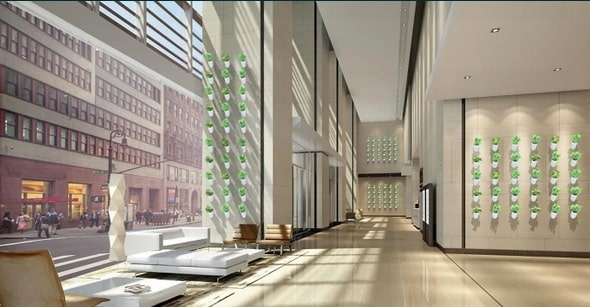Creo has unveiled its BioBulb platform that allows businesses to create appealing indoor plant walls with automated water and nutrient systems.
The system uses AI to create a smart, green living system that allows nature to grow in environments with scarce resources, such as inside office building lobbies.
The integrated system for buildings and homes uses AI to learn the optimal growth for a plant within its surroundings and autonomously infuses it with the precise amount of water and nutrients it needs. Creo can put the plants on walls and connect them with small plastic wires that deliver the nutrients and water as needed.
With more buildings introducing smart technologies, Creo believes it can make indoor air healthier to breathe and workspaces more appealing while improving overall indoor environmental quality.

Above: BioBulb lets you create plant walls anywhere.
Hooman Koliji, CEO of Sausalito, California-based Creo, said in an interview with VentureBeat that we spend more than 90% of our time indoors so it’s about time we make those environments feel more like nature.
“The idea is to systematically be able to integrate nature [into] buildings in a very sustainable fashion, virtually zero-based and almost virtually zero-maintenance,” Koliji said. “Everybody loves to have plants in buildings, commercial or residential or industrial, but the maintenance is a big hassle. They’re wasting so much water, and our system is dry 95% of the time.”
BioBulb was built to sustain the diversity of nature’s ecosystem. Creo’s AI software, dubbed Darwin, learns the optimal growth for each plant in various contexts and optimizes the use of resources, as well as providing insights into the future of a plant’s indoor growth.
The company started 2.5 years ago with a focus on developing technologies. During the pandemic, Creo shifted its research and development outside of the U.S., and it finished working on its first product in November. The company currently has a couple of customers, including a real estate company. Creo charges installation fees, as well as subscription fees for maintenance.
The company has raised $500,000 from investors and it has six employees. Creo is part of Autodesk’s residency program.
How it works

Above: BioBulb lets you grow plants efficiently and sustainably indoors.
The BioBulb system uses three different groups of sensors to monitor a plant’s vitals — one in the roots to check temperature, pH level, humidity, and nutrients. Another sensor monitors the surface of leaves and observes light density, and the third sensor measures the ambient environment surrounding the plant. It also has a computer vision camera that visually detects the plant’s growth.
People can hang BioBulb as a modular system on a lobby wall or conference room ceiling. It can be expanded to different locations in the building while remaining centrally controlled. Tubes connect the BioBulb to the Bio-Server, which is hooked up to the building’s water source. Through the sensors, it understands the plant’s needs and acts as a precision feeder by printing nutrients into a stream of water it infuses directly into the plant.
Koliji said BioBulb is a virtually zero-waste system because it uses a patented technology for the distribution of water, nutrients, and data that’s similar to nature’s underground root systems. Compared to existing high-tech alternatives, BioBulb said it moves and uses the least amount of water — up to 85% less — and uses up to 50% less energy.
Creo competes with hydroponics systems that are based on growing plants in water, but BioBulb uses soil and small amounts of water to be more efficient.

Above: That’s a smart plant.
“These are all connected through a network of hybrid connectors that allows liquid, data, and nutrients to pass through,” Koliji said. “They’re fully autonomous, and they’re getting water and nutrients through a central device that we call a bio server.”
Koliji said the water and nutrient source is programmed to deliver the right amount to the plant as needed, and it sprays the water and nutrients onto the plant much like an inkjet printer does. The whole system is data-driven and powered by AI.
“Instead of printing color, it prints macronutrients and micronutrients,” Koliji said. “We are learning from the plants to get the most accurate readings, and we use a camera and computer vision to detect the growth and color of a plant. We are getting really great insights about how plants live in different environments and what is actually required to keep them alive with a bare minimum of resources.”
One of the common problems with office plants is that they are overwatered and overfed with nutrients. They grow too quickly and have to be pared back. Or the opposite happens, where people forget to take care of them.
“The oxygen that plants produce helps us have healthier employees. But most importantly, there are microorganisms living under a root system of plants that metabolize volatile organic compounds (VOCs). So it cleans the air,” Koliji said.
Article: Creo unveils AI-based BioBulb for indoor plant walls
